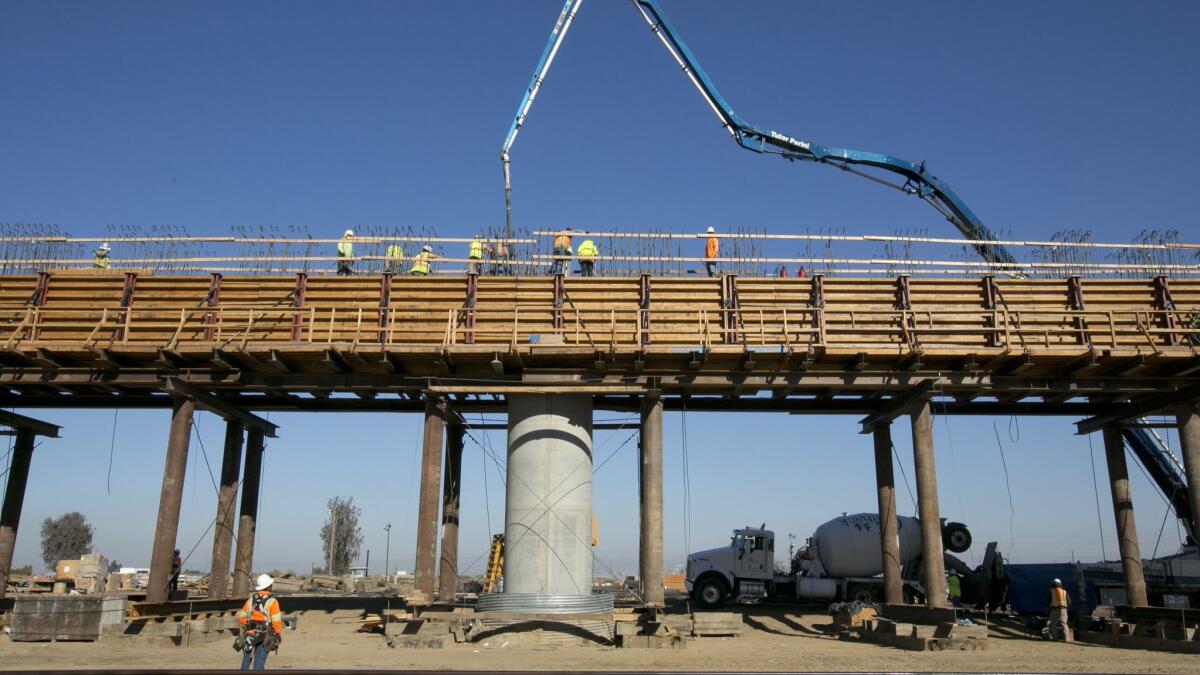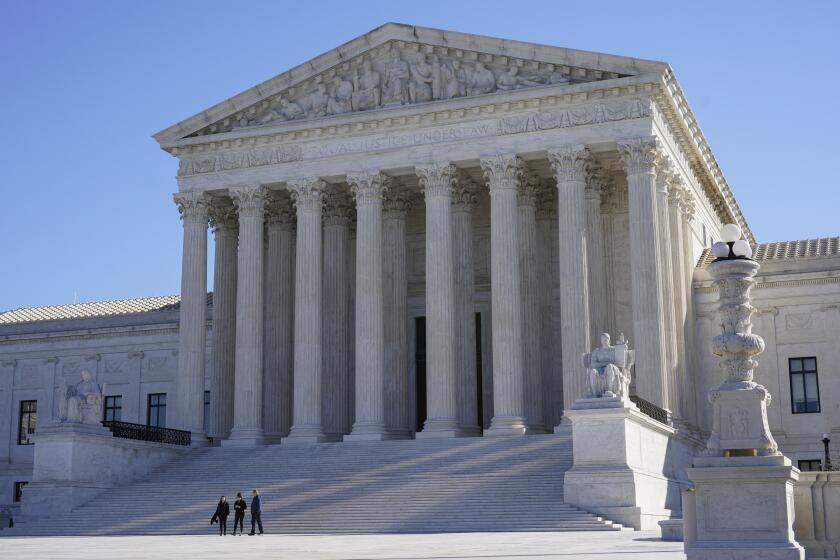As bullet train costs rise, only 31% of California voters want to keep paying for it

- Share via
Californians still support the concept of a bullet train from Los Angeles to San Francisco, but after months of troubling disclosures about the project’s cost and schedule, just 31% of voters across the state want to keep building it, according to a USC Dornsife/Los Angeles Times poll.
The survey confirmed what has been consistent in California public opinion for half a decade: The public has never abandoned its dream of a high-speed transportation system but rejects the rail authority’s performance in building it.
One of the project’s challenges revealed by the poll is a deep geographic divide. Bay Area voters, who would get the biggest and earliest benefits of the project, are its strongest supporters. A smaller majority support it in Los Angeles, while most respondents in San Diego and Orange counties are opposed. The Central Valley, which is seeing a construction industry employment boost but also suffering through widespread disruption, has the largest pool of opposition.
About 48% of the poll’s 835 respondents said that in general they strongly or somewhat support the project, while 43% oppose it. USC poll director Jill Darling said those are not strong numbers of support or opposition, given the poll’s margin of error of 4 percentage points.
But when asked in a second question whether they would stop the project, given that the cost has doubled to $77 billion and the schedule has stretched to 2033, just 31% said they would keep going and 49% said they would halt construction. A sizable 19% did not know what to do about the problems.
Whether the vagaries of public opinion could alter the course of the project is doubtful, given the strong support from Gov. Jerry Brown, big-city mayors, legislative leaders, transportation officials, organized labor, the construction industry and engineering consultants across the state.
A 2012 poll by The Times and USC just before a key vote in the Legislature showed 59% of voters would oppose the bond measure that was passed in 2008 to fund the project if it were put back on the ballot. Shortly after, the Legislature passed and Brown signed a multibillion-dollar appropriation out of the bond measure to start construction.
The rail authority’s new chief executive, Brian Kelly, said he sees some good news in the most recent polls.
“This poll appears to show that even after the authority just laid out the key challenges for the project related to schedule and cost, more Californians continue to support the concept of high-speed rail than not,” Kelly said in a statement. “That finding is consistent with another recent poll in March from the Public Policy Institute of California. Our job is to deliver this project which will provide Californians with mobility, environmental and economic benefits. That is what we are focused on doing.”
Kelly and other rail officials say the project is fully inclusive of all of the state’s major regions, but an increasing number of Southern Californians appears to question whether the balance is fair.
Under a draft 2018 business plan, the California High-Speed Rail Authority is committed to helping create a 70-mile electrically powered commuter train route from Gilroy to San Francisco, building a massive train station in downtown San Francisco and making other investments. The first partial operating segment would start in the Bay Area and run to the Central Valley.
By contrast, the project in Southern California is funding improvement for a freight railroad crossing south of downtown Los Angeles and redesigning tracks at Union Station. Though those are important, they don’t have the scale or impact of the Bay Area projects. And there is no funding in sight for a bullet train connection to Southern California.
Such disparities could jeopardize public support for the project, said Martin Wachs, a member of a peer review panel that oversees the project and a UCLA transportation expert. This year, Anthony Rendon, speaker of the state Assembly, said he is concerned about the spending disparity given that the project does not have enough funding to complete its plan.
Coverage of California politics »
»
Darling, the USC survey director, said that the findings reflect already weak support in Southern California and that if voters become aware of the possibility that the rail may never reach their area, support could evaporate. Just 27% of poll respondents in the Bay Area said they would stop the project, compared with 41% in Los Angeles, 56% in San Diego and Orange counties and 64% in the Central Valley.
“Is the higher support in the north the result of more spending there or a more liberal and environmentally minded electorate?” Wachs said. “It is likely both.”
Richard Katz, former Democratic majority leader in the Assembly and a longtime Southern California transportation official, said the Bay Area popped ahead early in the program when House Minority Leader Nancy Pelosi (D-San Francisco) said she wanted to draw funding from the project for the Transbay Transit Center, the bullet train’s future terminus in San Francisco. The concentration of power by Pelosi, Sen. Dianne Feinstein, former Sen. Barbara Boxer and Brown gave the Bay Area an advantage, Katz said.
Tom Umberg, who chaired the rail authority’s board of directors before current leader Dan Richard and is now a state Senate candidate in Orange County, said, “One of my challenges is to make sure we get our fair share of the benefits.”
A geographic disparity in rail spending is a new political problem for the state and contrasts sharply with highway spending, which is funded by mandated revenue sources, said Art Bauer, a former state Senate staffer who participated in the early formulation of the high-speed rail project.
“The highway program is a like a river, and all the local governments have water rights along it,” Bauer said. “The program is designed to trend toward equity. This rail program has become ‘I have mine and you can’t have yours.’ ”
Jill Darling, survey director, USC Dornsife Center for Economic and Social Research, contributed to this report.
Follow me on Twitter @rvartabedian
ALSO
New poll finds a volatile race for second place in California governor’s contest
More to Read
Get the L.A. Times Politics newsletter
Deeply reported insights into legislation, politics and policy from Sacramento, Washington and beyond. In your inbox twice per week.
You may occasionally receive promotional content from the Los Angeles Times.











